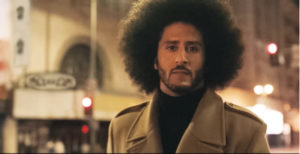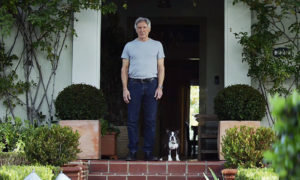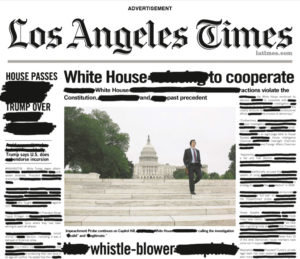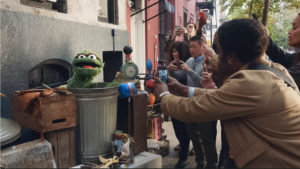Turn on the television. Pick up a magazine. Scroll through your Twitter feed. Chances are, you’re being inundated with hundreds of marketing campaigns. But news publishers are only producing a fraction of those, and as an industry, we need to do better.
We can’t allow individuals to dictate our identity as “fake news.” We can’t let headlines be flooded with news about layoffs and closures. We must step up and share with our readers—and even our critics—the good work being done in newsrooms around the country. If we don’t communicate the efficiency and power of journalism, who will?
E&P spoke with various news publishers about their recent marketing campaigns and found what happened when they took matters into their own hands.
Read Yourself Better, Wall Street Journal
In world full of noise, the Wall Street Journal chose to call out the issue that digital overload might be hindering an individual’s ability to understand important subjects and issues in its latest campaign, Read Yourself Better.
The campaign launched last November with a 90-second spot directed by Juan Cabral. The film depicts intriguing—and at times—odd images of individuals going about their day with interruptions from text messages, memes, pop-up advertisements and more. Aside from the film, the campaign consists of home, online video, social media, print and display advertising. The Journal also had a mural commissioned in Brooklyn that depicts the same themes as the film.
For a short time, the Journal had a pop-up vending machine which allowed spectators to trade in a piece of printed media for a copy of the newspaper or they could unlock the website with near-field technology as they walked up to the vending machine. While the machine has since been put away, Paul Plumeri, vice president of global marketing, said it could make a return in the future.
The&Partnership agency—a longtime collaborator with the Journal— helped get the campaign off the ground. In early 2019, the Journal and the agency began talks about creating a campaign that would highlight the Journal’s point of view and place in the media industry, according to Agnes Fischer, president of the The&Partnership’s New York office.
“We were also trying to find a brand idea that would help them support all of their initiatives (so they) could live under this one brand umbrella,” she said. “Hopefully what you’ll see in the future from us will all fall under Read Yourself Better.”
Research helped narrow down ideas for the campaign and the target audience. The Journal and The&Partnership found that those who subscribe to the newspaper often have a strong sense of self determination—the group of people they sought. They wanted this group of people to reach beyond the static and rely on true quality journalism to drive their decisions.
Once the idea was selected the rest came together quickly, Fischer said. The film took five days to produce, and during that time, the agency captured as many assets as they needed for social media and digital.
When asked why marketing and branding should be a priority to publishers, Plumeri said, “There’s only so much disposable income for subscription services…so we need to make our positioning and our value very clear. We also need to make sure that the promises that we’re making are the promises that we’re keeping.”
Truth, New York Times
According to New York Times executive creative director of marketing Laura Forde, the aftereffects of the 2016 presidential election was the perfect moment in time for the paper to talk about the role of independent reporting and its role in society.
The result was the Truth campaign, which launched in February 2017. The first television spot (Truth is Hard) aired during the Academy Awards that year. According to AMA Marketing News, the commercial ran for a week after the televised awards ceremony and digital ads continued for a month. It also ran in ads online and in print.
A few months later, the Times released a set of commercials directed by Darren Aronofsky. The commercials each showed a series of images from a story with the credited photojournalist narrating the scenes.
Since launching nearly three years ago, the Truth campaign has shifted to other important topics. The 2018 campaign, Truth Has a Voice, highlighted sexual harassment and the Times’ reporting on the Harvey Weinstein scandal. And more recently, the Times released Truth is Local, featuring New York City’s five boroughs and the paper’s commitment to local reporting.
Helping with the Truth campaign is Droga5, a New York City-based digital advertising agency.
“Our team at Droga5 are exceptional strategic and creative partners,” Forde said. “They are able to create work that highlights our mission, breaks through the clutter and resonates with people emotionally, while adhering to our standards for accuracy.”
The reaction to the campaign from readers was immediate, she said. Readers took photos of the print ad and posted them on Instagram. They hung the ads in their apartment and store windows. There attended a press freedom rally outside the Times building with people holding up the ad in support of the newspaper. Even “Late Show” host Stephen Colbert made a parody of the television spot—which Forde considered a compliment.
As reported by Droga5, due to the Truth campaign, the first quarter of 2017 became the Time’s “best quarter ever for subscriber growth,” and in the second quarter, the “paper passed 2 million digital-only subscribers, a first for any news organization.” The agency also reported the campaign received 5 billion earned impressions, $16.8 million earned media value and several awards including two Gold Cannes Lions and a Webby Awards for People’s Voice.
“We know that people really want to understand the world, arguably more than ever before,” Forde said. “There are 1,700 people in our newsroom working incredibly hard every day. We think that story doesn’t get told enough. It’s our job in marketing to highlight the rigor, integrity and independence of our journalism, and the positive impact it has on society.”
What Matters, Dallas Morning News
When the Dallas Morning News launched its What Matters campaign last fall, it was really a reintroduction into the community.
The Morning News kicked off the campaign with a popup event in September to coincide with the relaunch of the newspaper website. This event provided free coffee and copies of the paper, both print and digital (the latter was good for three months). In addition, large chalkboards were set up posing the question “What matters?” where guests were invited to share their answers. Some of the top answers included family, love, friends, kindness and community. The subjects written on the chalkboards were also integrated into the newspaper’s content. For example, one common subject that came up was veterans, so the Morning News created a Military and Veterans section.
“We took the handwriting samples from the chalkboards and that’s what we integrated into our ads throughout town to illustrate that this is a dialogue with our audience, our community,” Dan Sherlock, head of digital and brand marketing, said.
In its entirety, the campaign consists of posters, stickers, popup events and advertising.
To help create this campaign, the Morning News enlisted the help of GoDo Discovery Co., a local advertising agency.
A lot of companies go straight to pitching creative and interesting ideas, Sherlock explained, but GoDo first spent time with the Morning News interviewing internal and external stakeholders to find out who the newspaper was and why they continue to do what they do—a process Todd Lancaster, CCO for GoDo, called a GoDo Session. In addition, the newspaper partnered with Praxis Research to conduct external research about their brand. All the collected feedback and data was translated into the What Matters campaign, which GoDo pitched to them.
Lancaster said you hear people from all over the world ask, “What matters?”
“But if we’re reintroducing (the Morning News), and if we are going to tell people local journalism matters and that you need to read it, it needs to be (about) something that the people actually care about,” he said.
After the green light was given, it took a few months to build the pieces of the campaign. Before launching publicly, the Morning News launched the campaign internally at an event, where staff also got the chance to share what matters to them.
Sherlock hopes the campaign can last and extend into various topics for years to come. In fact, the newspaper already plans that it will play a part in celebrating their upcoming 135th anniversary in October.
The Klay Offer, Bay Area News Group
In 2017, the Bay Area News Group (BANG) discovered something refreshing: the popular Golden State Warriors basketball player Klay Thompson reportedly loved reading the newspaper before every game. BANG immediately reached out to see if the star athlete would be interested in working together, and by spring 2017, Thompson was signed on to become a spokesperson.
“We thought this would really help us bring awareness to our brand with younger readers…and kind of show them there’s value in reading the newspaper and looking at the newspaper as an authentic news source,” said Olga Mitina, BANG marketing director.
In October 2017, the Klay Offer launched with the slogan, “Start a new ritual, read the paper.” The campaign features a landing page (klayoffer.com) which offers digital access to any one of BANG’s three local daily publications for 11 months for 11 cents a day (11 is Klay’s jersey number). The offer also includes Sunday print and digital for $3.50 a month. Also part of the campaign were television and radio spots, billboards, king-sized bus posters, in-house ads, Facebook ads, email, and creative point-of-sale promotions, such as life-size Klay cutouts.
BANG’s in-house design team created all assets of the campaign, except for the slogan and the videos. The organization worked with Division of Labor, a San Francisco advertising agency, for the first year of the campaign,and Atomic Productions, a production company based in Emeryville, Calif., for the second year.
In 2018, BANG also received an inquiry from Anta, a China-based sportswear company and Thompson’s biggest sponsor, about teaming up to launch a new shoe featuring some of Thompson’s greatest moments and milestones.
When BANG launched this campaign and partnership, Mitina said they did not know what to expect, but data reflects positive results.
When the group launched the first campaign video with Thompson—with zero promotion—it went viral with more than 37,000 organic views. In addition, for the first year of the campaign, brand awareness increased from 27 percent to 56 percent and the likelihood to purchase doubled. The landing page saw more than 2,000 offers selected in the first year and more than 7,000 in the second year. The average retention during the Klay Offer (starting at 26 weeks) was 71 percent, and at 12 months, the retention for the offer was 69 percent compared to 48 percent for all starts.
Supporting Local Journalism, Newsday
In Long Island, Newsday launched the Supporting Local Journalism campaign in June 2019, which highlights the vital role that local journalism plays in the community.
The campaign ran for five weeks across Nassau and Suffolk counties. It included a variety of 30-second ads that ran across television networks, and it played before stories and feature videos on Newsday’s website. Audio versions were also played across several radio stations. In addition, the campaign was promoted through digital, email and social media.
Supporting Local Journalism was created in-house, where over the course of six months in 2018, Newsday’s consumer marketing team met weekly to brainstorm ideas for a cross-platform campaign that highlighted their journalists. Research was conducted to find which Newsday investigative stories had the most impact in the community. As a result, five journalists were chosen to appear in the campaign to discuss their work.
“We focused on writing, researching, interviewing and filming our watchdog and investigative journalists who are extremely passionate about the stories they tell,” Royston Wilson, director of marketing, said. “This allowed us to create promotions that forge a more personal relationship between the newsroom and our readers.”
The most important message the news organization wanted to convey to subscribers was that their continued investment in Newsday produces groundbreaking stories that bring about positive changes in the community, Wilson explained.
He added that Newsday also felt that it was important to share with readers that “strong, local journalism takes courage, costs money and depends on the support of the local community.”
A reader survey for this campaign revealed that 61 percent felt the newspaper made Long Island a better place to live, 49 percent of respondents felt local journalism would be threatened or disappear if readers didn’t subscribe, and 52 percent believed paying for news provided better coverage.
Although the campaign has ended, Newsday is considering extending the campaign with new stories and reporters—and the organization now has greater motivation to market their brand.
“It’s essential...Branding represents who we are as an organization, what we believe in and how we want to be perceived by the audience,” Wilson said. “It allows us to speak to our readers and inform them about what their subscription supports and delivers in terms of value to their lives and communities.”
A Few More Brands
We looked outside the world of publishing to see what other creative and effective marketing campaigns caught our eye. Check them out below.
 In 2009, National Geographic Society launched its Big Cats Initiative to bring awareness to the decline of big cats in the wild. Last year, the Society expanded the campaign with the Save Archie campaign. The organization enlisted street artist, Dean Zeus Colman, to design a missing cat poster for the lion, which was then drawn on the floor of London’s Paternoster Square so that when pedestrians walked across it, the image slowly faded away.
In 2009, National Geographic Society launched its Big Cats Initiative to bring awareness to the decline of big cats in the wild. Last year, the Society expanded the campaign with the Save Archie campaign. The organization enlisted street artist, Dean Zeus Colman, to design a missing cat poster for the lion, which was then drawn on the floor of London’s Paternoster Square so that when pedestrians walked across it, the image slowly faded away.
 Nike’s Dream Crazy campaign started with a two-minute commercial narrated by football player Colin Kaepernick, who had recently been rejected by the NFL after protests during the national anthem to call attention to racial injustice. The video portrays a host of athletes, from Serena Williams to Isaiah Bird, a 10-year-old wrestler from Long Island. The campaign also included multiple print ads featuring athletes in black and white with mantras front and center.
Nike’s Dream Crazy campaign started with a two-minute commercial narrated by football player Colin Kaepernick, who had recently been rejected by the NFL after protests during the national anthem to call attention to racial injustice. The video portrays a host of athletes, from Serena Williams to Isaiah Bird, a 10-year-old wrestler from Long Island. The campaign also included multiple print ads featuring athletes in black and white with mantras front and center.
 Amazon’s 2019 Super Bowl spot poked fun at itself with its 90-second spot titled “Not Everything Makes the Cut.” As described by The Drum, a group of celebrities including Harrison Ford, Forest Whitaker, Ilana Glazer, Abbi Jackson take part of an Alexa beta test group. They test out dog collars that enable pets to order more food with every bark, toothbrushes that can’t be heard when brushing and other items that all fail to be useful in a hilarious way.
Amazon’s 2019 Super Bowl spot poked fun at itself with its 90-second spot titled “Not Everything Makes the Cut.” As described by The Drum, a group of celebrities including Harrison Ford, Forest Whitaker, Ilana Glazer, Abbi Jackson take part of an Alexa beta test group. They test out dog collars that enable pets to order more food with every bark, toothbrushes that can’t be heard when brushing and other items that all fail to be useful in a hilarious way.
 Amazon Studios timed the release of their film “The Report,” which follows the Senate Intelligence Committee as they investigate the CIA’s use of torture following 9/11, with a marketing campaign that took over the front page of the Los Angeles Times, USA Today, Chicago Tribune, San Francisco Chronicle and Dallas Morning News. According to Adweek, the newspapers were wrapped in faux, redacted versions of frontpages and mastheads.
Amazon Studios timed the release of their film “The Report,” which follows the Senate Intelligence Committee as they investigate the CIA’s use of torture following 9/11, with a marketing campaign that took over the front page of the Los Angeles Times, USA Today, Chicago Tribune, San Francisco Chronicle and Dallas Morning News. According to Adweek, the newspapers were wrapped in faux, redacted versions of frontpages and mastheads.
 A Squarespace and Sesame Street collaboration recently hit the top five list of creative brand ideas on AdAge. The two companies had teamed up to celebrate the 50th anniversary of the show and produced a video with Oscar the Grouch among his piles of trash which get mistaken for modern art and uploaded to a Squarespace website. Oscar quickly becomes famous despite his protests. Fans could even purchase limited-edition art capsules from OscarTrashArt.com, which quickly sold out. All proceeds went to the Sesame Street Workshop.
A Squarespace and Sesame Street collaboration recently hit the top five list of creative brand ideas on AdAge. The two companies had teamed up to celebrate the 50th anniversary of the show and produced a video with Oscar the Grouch among his piles of trash which get mistaken for modern art and uploaded to a Squarespace website. Oscar quickly becomes famous despite his protests. Fans could even purchase limited-edition art capsules from OscarTrashArt.com, which quickly sold out. All proceeds went to the Sesame Street Workshop.
Comments
No comments on this item Please log in to comment by clicking here